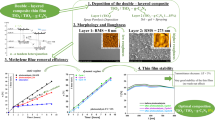Abstract
Photocatalysts that are used for waste water treatment are often suspended in the waste water during processing and then must be removed from the water after treatment. To reduce the post-degradation expenses and time, separation is facilitated by an immobilization process. The effect of immobilized TiO2 geometries on the photocatalytic behavior of the photocatalyst is investigated in this work. Powder, fiber, film, and network-shaped TiO2 nanocatalysts were produced by using different templates. The cellulose fiber and ceramic templates were used as substrates for fiber and film/network geometry production. The products were characterized by x-ray diffraction (XRD), scanning electron microscopy (SEM), and Brunauer-Emmett-Teller (BET) surface area measurement. The photocatalytic performance was determined by methyl orange degradation and cyanide photo-oxidation under ultraviolet irradiation. From the SEM images, the size range of the TiO2 particles in the film and in the network geometries were 20-60 nm. The nanoparticles had covered the surface of the substrate, uniformly. Removal of the cellulose substrate by heat treatment yielded hollow TiO2 fibers with diameters of 0.5-1 µm and lengths of 30 µm. The efficiencies of both photocatalytic reactions were obtained in the following order: powder > network > film > fiber geometry. The rate constant of the dye degradation reaction using powder catalyst was 0.0118 min−1. For network catalyst, it was 0.0083 min−1. Corresponding results for cyanide disinfection were 0.0055 and 0.0046 min−1. Although powder samples had higher rate constants, network geometry was preferred due to its higher immobility.










Similar content being viewed by others
References
H. Koohestani, and S.K. Sadrnezhaad, The influence of structures on the TiO2 photocatalytic properties, 5th International Conference on Nanostructures (ICNS5), 2014, Mehregan Ghalam, Kish Island
M.J. Benotti et al., Evaluation of a Photocatalytic Reactor Membrane Pilot System for the Removal of Pharmaceuticals and Endocrine Disrupting Compounds from Water, Water Res., 2009, 43(6), p 1513–1522
S. Ray et al., Removal of Nitrate and COD from Wastewater Using Denitrification Process: Kinetic, Optimization, Statistical Studies, Clean Technol. Environ. Policy, 2014, 16(2), p 291–301
R. Salazar, E. Brillas, and I. Sirés, Finding the Best Fe2+/Cu2+ Combination for the Solar Photoelectro-Fenton Treatment of Simulated Wastewater Containing the Industrial Textile Dye Disperse Blue 3, Appl. Catal. B, 2012, 115, p 107–116
M.N. Chong et al., Recent Developments in Photocatalytic Water Treatment Technology: A Review, Water Res., 2010, 44(10), p 2997–3027
Y. Okour et al., Preparation and Characterisation of Titanium Dioxide (TiO2) and Thiourea-Doped Titanate Nanotubes Prepared from Wastewater Flocculated Sludge, Bioresour. Technol. , 2010, 101(5), p 1453–1458
C.M. Teh and A.R. Mohamed, Roles of Titanium Dioxide and Ion-Doped Titanium Dioxide on Photocatalytic Degradation Of Organic Pollutants (Phenolic Compounds and Dyes) in Aqueous Solutions: A Review, J. Alloys Compd., 2011, 509(5), p 1648–1660
N. Laoufi, D. Tassalit, and F. Bentahar, The Degradation of Phenol in Water Solution by TiO2 Photocatalysis in a Helical Reactor, Glob. NEST J., 2008, 10(3), p 404–418
A.H. Jawad, A.F. Alkarkhi, and N.S.A. Mubarak, Photocatalytic Decolorization of Methylene Blue by an Immobilized TiO2 Film Under Visible Light Irradiation: Optimization Using Response Surface Methodology (RSM), Desalin. Water Treat., 2014(ahead-of-print), p 1–12
T. An et al., Photocatalytic Degradation Kinetics and Mechanism of Antivirus Drug-Lamivudine in TiO2 Dispersion, J. Hazard. Mater., 2011, 197, p 229–236
S. Papageorgiou et al., Alginate Fibers as Photocatalyst Immobilizing Agents Applied in Hybrid Photocatalytic/Ultrafiltration Water Treatment Processes, Water Res., 2012, 46(6), p 1858–1872
A.Y. Shan, T.I.M. Ghazi, and S.A. Rashid, Immobilisation of Titanium Dioxide onto Supporting Materials in Heterogeneous Photocatalysis: A Review, Appl. Catal. A, 2010, 389(1), p 1–8
E. Khaksar, M.S. Afarani, and A. Samimi, In Situ Solvothermal Crystallization of TiO2 Nanostructure on Alumina Granules for Photocatalytic Wastewater Treatment, J. Mater. Eng. Perform., 2014, 23(1), p 92–100
L. Lim, R. Lynch, and S.-I. In, Comparison of Simple and Economical Photocatalyst Immobilisation Procedures, Appl. Catal. A, 2009, 365(2), p 214–221
K. Nakata and A. Fujishima, TiO2 Photocatalysis: Design and Applications, J. Photochem. Photobiol., C, 2012, 13(3), p 169–189
X. Zhang, et al., “Construction of Self-Supported Three-Dimensional TiO2 Sheeted Networks with Enhanced Photocatalytic Activity,” Scientific Reports, 2013, vol. 3
J. Militky, Structure and Properties of Cotton Fiber: A Literature Review, 2009, Dr Muhammad Mushtaq Mangat
E.W. Rice, and A.P.H. Association, Standard Methods for the Examination of Water and Wastewater, 2012, American Public Health Association, Washington, DC.
K.J.A. Raj and B. Viswanathan, Effect of Surface Area, Pore Volume and Particle Size of P25 Titania on the Phase Transformation of Anatase to Rutile, Indian J. Chem. A, 2009, 48, p 1378
C. Wang et al., Reaction Kinetics of Photocatalytic Degradation of Sulfosalicylic Acid Using TiO2 Microspheres, J. Hazard. Mater., 2009, 163(2), p 1101–1106
E.M. Rodríguez et al., Mechanism Considerations for Photocatalytic Oxidation, Ozonation and Photocatalytic Ozonation of Some Pharmaceutical Compounds in Water, J. Environ. Manag., 2013, 127, p 114–124
I. Ibrahim, A. Ismail, and R. Mohamed, Degradation of Free Cyanide by Photocatalytic Oxidation, Eur. J. Miner. Process. Environ. Prot., 2003, 3(3), p 281–290
Author information
Authors and Affiliations
Corresponding author
Rights and permissions
About this article
Cite this article
Koohestani, H., Sadrnezhaad, S.K. Photocatalytic Activity of Immobilized Geometries of TiO2 . J. of Materi Eng and Perform 24, 2757–2763 (2015). https://doi.org/10.1007/s11665-015-1535-9
Received:
Revised:
Published:
Issue Date:
DOI: https://doi.org/10.1007/s11665-015-1535-9



